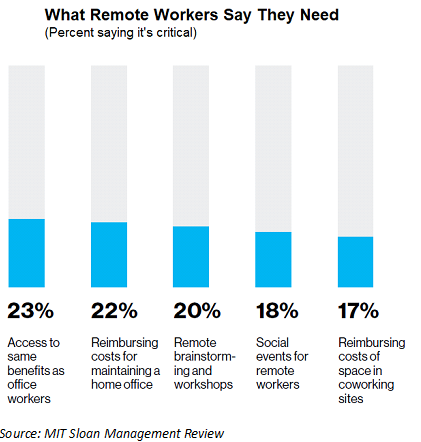Even before companies were able to adequately establish home-based workstations for their newly remote and hybrid employees, experts and business leaders were decrying the downsides of dispersed workforces. Citing analysis of historical precedents, they told us how operating outside the boundaries of a physical office would make it difficult to maintain company culture and dimmish work teams’ abilities to collaborate.
In turn, senior executives have expressed pronounced concerns over the impact of remote and hybrid work models on corporate culture and operations, said researchers at MIT Sloan Management Review. More than eight in 10 C-suite members surveyed by MIT Sloan Management Review say they are “somewhat” or “very concerned” about remote employees being able to participate fully in collaborative sessions. More than 80 percent fret about the ability of remote employees to make new friends, expand internal networks, and easily get someone’s advice on how to do things. About two-thirds of respondents agree that their organization believes it needs to have most employees working onsite to maintain the corporate culture.
“This belief is consistent among all industries and, to some extent, among the largest companies,” said MIT SMR analysts.
Such concerns, however, appear to be unmerited, as research from MIT SMR, among others, suggests many of the early concerns surrounding the difficulties and potential disconnectedness of remote working have not materialized. Remote and hybrid situations could even be improving workplace culture and team collaboration in certain ways. And as it turns out, executive leadership could be more important that geography when it comes to maintaining “the three Cs” of culture, comradery and collaboration.”
Most and least concerned about hybrid/remote work environments interfering with important interactions with managers/key colleagues
| Role | Very Concerned | Somewhat Concerned | Not at all Concerned |
| Board members | 29% | 43% | 29% |
| C-suite | 37% | 46% | 17% |
| Senior executives | 43% | 46% | 10% |
| Middle/Upper managers | 34% | 43% | 23% |
| Supervisor/Manager | 25% | 51% | 24% |
| Individual contributor
(non-manager) |
19% | 41% | 40% |
Source: MIT Sloan Management Review
“Beliefs appear to be trailing reality considerably in many companies,” said the MIT SMR report. “Only a tiny percentage of respondents — often fewer than 10 percent — say, in response to multiple questions, that hybrid work environments have a negative effect on corporate cultures.”
Nearly half of senior leadership and management surveyed by MIT SMR say that levels of camaraderie have improved since workers went remote and hybrid. Another 40 percent feel those levels have remained about the same, leaving only 9 percent saying the level of camaraderie declined.
Some might argue that current remote and hybrid environments leverage relationships established before the pandemic struck, when most people were still gathered in offices. But among those remotely full time prior to the pandemic, 47 percent say that levels of camaraderie have improved during the pandemic, while 41 percent believe things have remained the same. And among the 43 percent of respondents who began their jobs after the pandemic began in early 2020, the majority say their sense of fellowship has actually gotten better during that time.
“In other words: Physical colocation doesn’t appear to be totally necessary for developing esprit de corps, even among those new to their jobs,” said the MIT SMR report. “Regardless of seniority levels or length of tenure, employees are connecting and building relationships remotely, in large part via the use of telecommunications tools such as videoconferencing platforms and messaging apps.”
Indeed, rather than a growing disconnect from company and culture, as some assumed work arraignments of the past two years would induce, respondents’ level of trust in their companies, in how they are “seen and heard” and included, and clarity in their specific roles have largely improved if not stayed the same. Less than one in 10 respondents say both the ability to express their opinion (7 percent) and feelings of inclusion and diversity (6 percent) have worsened, compared to 46 percent of the former and 47 percent of the latter who said they have improved. Meanwhile, six in 10 say that they have been recognized more frequently for the work they do since switching to remote and hybrid environments.
The younger that survey respondents are, the more likely they are to see positive impacts on company culture from the use of hybrid working models, showed the MIT SMR findings. The ability to openly express personal opinions is an example: 59 percent of respondents in Generation Z (those born since 1995), 50 percent of millennials (born between 1980 and 1994), 41 percent of Generation X (born between 1965 and 1979) and 40 percent of baby boomers (born between 1946 and 1964) believe this has improved.
Most and least concerned about hybrid/remote work environmentsmaking it look like they’re insufficiently motivated about their careers
| Role | Very Concerned | Somewhat Concerned | Not at all Concerned |
| Board members | 33% | 42% | 25% |
| C-suite | 38% | 40% | 22% |
| Senior executives | 41% | 43% | 16% |
| Middle/Upper managers | 37% | 40% | 23% |
| Supervisor/Manager | 31% | 44% | 26% |
| Individual contributor
(non-manager) |
27% | 34% | 39% |
Source: MIT Sloan Management Review
The vast majority of respondents also believe that their companies’ leaders believe in them, show the MIT SMR findings. Two-thirds agree to a “considerable” or “great” extent that their companies’ leaders believe that individuals working at home will get their work done well and on time. Top executives appear most confident about that issue, with 84 percent of board members agreeing that their organizations’ leaders believe that home-based employees will do good work on time.
What’s more, a decisive majority of respondents (77 percent) “strongly agree” or “agree” that company leaders regularly check in with employees to see how they are doing, suggesting that digital tools have allowed for a type of “management by walking around” that some believed would be difficult to maintain with workers residing mostly outside the office.
Contrary to another common assumption regarding remote and hybrid workers, So far FOMO doesn’t appear to be a huge problem with remote and hybrid arrangements. Only about a third of all survey respondents identified it as worrisome. And the less senior employees are, the less likely they are to worry about FOMO at all. When asked to rate their level of concern about getting sufficient face time with their managers and others important to their careers, 43 percent of senior executives describe themselves as “very concerned.” Only 19 percent of individual contributors, on the other hand, consider themselves “very concerned” in that regard; “an impressive 40 percent say they’re not concerned at all,” said MIT SMR analysts.

Higher-level executives are also more worried that hybrid or remote situations could make them appear to be insufficiently motivated about their work or careers, of which 41 percent of senior executives are “very concerned” compared to about a quarter of individual contributors who are “very concerned.”
Likewise, a majority (52 percent) of respondents in the survey say the line of sight into their own career trajectories has improved, while another 36 percent say it remained about the same. Only 9 percent said their trajectories became less clear.
“Clarity likely stems from increased trust in management. The vast majority of respondents believe that management trusts them and that they are being recognized for the work they do,” said the MIT SMR study, which found that a large majority of 83 percent said they have confidence in their companies’ senior leaders to strengthen the overall sense of belonging.
“COVID hit suddenly like a thunderstorm,” added Kevin Martin, chief research officer at the Institute for Corporate Productivity. “With business under threat, managers and executives really rose to the occasion. And that seems to have made people much more comfortable and built their trust.”
Of course, digital communications tools and video conferencing, in particular, have played a large part in keeping folks collaborating and connected to culture. So, what about the dreaded Zoom fatigue? It might not be as prevalent as it is repeatedly mentioned.
According to Pew Research Center, most workers who regularly use online platforms to connect with co-workers say they are fine with the amount of time they spend on video calls. About one-in-four say they are worn out by it.
Perhaps folks have built up some stamina. Back in October of 2020, 37 percent of regular teleworkers who often used online conferencing said they were worn out by the amount of time spent on video calls, said Pew, although there was a larger percent of workers operating remotely.
If nothing else, this research suggests organizations have done a fairly good job of avoiding some of the expected and potential downsides of a dispersed workforce.
“I think it’s a fair statement to look at these findings and say that managers in remote and hybrid environments have very deep concerns and understand the possible pitfalls,” argued Robert C. Pozen, senior lecturer at the MIT Sloan School of Management Investments and coauthor of Remote Inc.: How to Thrive at Work … Wherever You Are (Harper Business, 2021). “They are being very intentional about how to manage these situations and seem to be pretty successful.”
It also should cause those organizations to pause as they consider “returning to normal,” argued MIT SMR researchers.
“It’s important,” concluded the research firm, “to preserve those gains in whatever new environments evolve beyond the pandemic, as opposed to simply going back to the ‘old normal.’”









